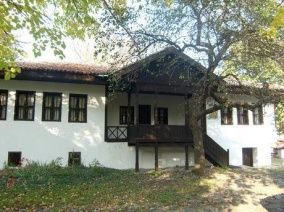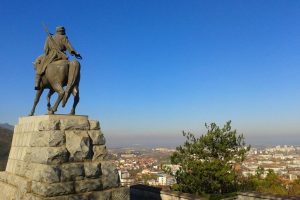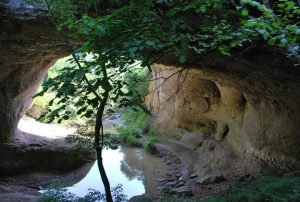

It belongs to the ethnographical complex Sofronii Vrachanski from Vratsa and it is dedicated to the first Bulgarian diplomat who worked at the imperial court from Russia, having important contributions at the liberation of the Bulgarian people from under the Ottoman domination. The ethnographical complex presents evocative exhibits of the handicrafts and the traditional creations of the locals from the end of the 19th century – the beginning of the 20th century. The memorial house presents aspects of the diplomat’s life, and his creations. The architectural style belongs to the Renaissance period from Bulgaria, whereas inside there are exhibits and unique sculptures executed by the artist Zachari Zograf.
The “golden” exhibits
The presence of the mineral and the aurate sand deposits in the rivers from Vratsa are the favorable factors which contribute to the appearance and to the development of these occupations of building watercrafts to become a real art. The special works from the Goldsmiths School from Vratsa literary floods the entire country and they arrive on the international market. The goldsmiths school Zenith arrived in the XIXth century. The experts in the working technique of the thin white embossed gold, and the goldsmiths make in principal works of jewelries and religious properties.
The exhibit presents the completely equipped workshops with working layers for jewelries, a set of instruments of a goldsmith and casts.
The most typical among the works of the goldsmiths are the “arpatii” pomegranate earrings with a different of beads, grains and bows, collections of melted chains or plates of individual unities “fish bones”, buckles – the hammer, refined pins, also earrings and broaches.
In the vast majority of the goldsmiths there also enter bronze works, dusts corns, handles for the petards, for the church: crosses, candles, plates for the books and for the icons and glasses. The goldsmiths from Vratsa execute decorations on the gun and pistols stocks, golden and silver handles, and the incrustations of the metallic pieces from the yatagans, knives, daggers and swords.
In 1907, at the exhibit from London from the Balkan countries it attends with their collection the gem Dimitar from Vratsa and receives a golden medal.
The goldsmith tradition is kept until the first quarter of the XXth century. When the decline started, this was affected by the competition from the golden factory.
The exhibit:
“Traditional and modern canvases produced by the growing of the silkworms”
The tradition of growing the silkworms in Vratsa is very old and in the entire country. The discovery, despite all of these, of the sericulture station in Vratsa in 1893 gives a powerful impulse for the development of the sericulture in the region of Vratsa. During the spring season, especially in the villages, almost no family grew silkworms as an additional source by the funds and obtained at home silk and silk fabrics, transforming the silk fabric into an art.
In the first part of the exhibit it is shown the old, primitive path of growing the silkworms, the original one. The type of horizontal looms for the home from Vratsa, curled cocoons. Perfectly conserved there are exhibited the diploma and the golden medal of Maria Pishtikova from Vratsa – one of the twenty three participants, winner at the World Exhibit from St. Louis, Louisiana, the United States of America, in 1904, for her collection of silk fabrics textured by home.
The second part of the exhibit loans materials which show the modern method of growing the silkworms and the accomplishments of science in the field of sericulture – new hybrids and types of mulberries.
The continuity in the production of silk fabrics is presented in the collection of fabrics “Jordan Lyutibrodski” in Vratsa.
The exhibit:
“The traditional viticulture and Oenology”
The exhibit is arranged in the basement of the house – museum “Ivan Zambin”. The viticulture and the wine making are known in Vratsa even from the oldest times. The climatic conditions are extremely favorable, especially in the hill areas. In the area Podvesleshkiya even in the years of Ottoman domination there have been created farms especially semi-closed, self-sufficient farms which produce, principally, grapes and wine.
The viticulture is a major stake in the means of existence of the population from Vratsa and of the commerce with wine – too profitable for the individual owners and for the big businessmen. Through the favorable proximity of the Danube and of the international commercial relations, the Vratsa wines are known in the country and much far away from its borders. In 1893 and in 1894 in Montpellier (France) and in Sadovo there are analyzed the wines from Vratsa and it is proven the fact that the flavor, the quality and the bouquet aren’t found on the Rhine. At the first Fair from Plovdiv in 1892 the wine-makers from Vratsa won silver and bronze medals for their products and Stefan Kraskiyov – the biggest honor, an honor diploma. The later ones won prizes from all the internal and the external exhibits, in which they attend – the Honor Diploma of the exhibit from Plovdiv, Anvers, Bordeaux, Chicago, Cairo Grand Prix from Brussels and a golden medal from Cairo and from Paris.
Of a special interest in exhibit are the sculpted fences in wood for the grape transportation, barrels of 5000 liters, wine labels and the diplomat Stephen Kraskiyov.




